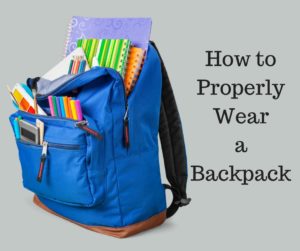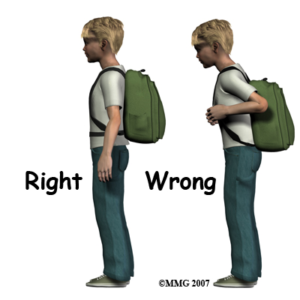
It’s back to school time, which means that kids across the country are filling their bags with heavy books and hauling them from class to class. It is important to get an appropriate backpack for kids and to ensure that they are wearing them properly in order to reduce likelihood of back, neck, and shoulder pain and potential injury.
Here are some quick tips to correctly position and carry the load of a backpack.
- Always wear both shoulder straps. rather than slinging the backpack on with only one strap on one shoulder
- Adjust the shoulder straps so that the backpack is high on the back and the shoulder straps are comfortable on the shoulders, as shown below:

- The backpack should not sway from side to side during walking. If it does, the straps are too loose.
- If the backpack has a waist strap or pectoral strap (across the upper chest area) – use it. Waist straps help distribute weight load to hips, relieving shoulder pressure. A pectoral strap helps keep shoulder straps in place in order to reduce backpack sway.
- Heaviest items should be placed closest to the child’s back. Materials should be placed so as not to slide.
- A child’s backpack should never weigh more than 10% their body weight. If backpacks are too heavy and/or are worn for prolonged periods, compression can develop on nerves or arteries that pass from the lower neck to the armpit, causing pain and other problems. Symptoms of nerve compression may include pain, weakness, and/or numbness and tingling down the arm. Symptoms of arterial compression may include pain, the sensation of cold, and/or pale skin tone in the arm.
Here are two commonly incorrect ways to wear a backpack, along with an explanation of why the wearing style could put the wearer at risk for injury.
- The One Strap Sling Method of Wearing – This is a common way for kids and teens to wear their backpacks. Unfortunately, using only one strap puts asymmetrical pressure on one shoulder and the upper back and neck. This asymmetrical loading can cause shoulder, neck, and/or back pain, as well as headaches and possibly also upper limb sensation issues like tingling or a cold sensation. The uneven pressure of the backpack creates poor posture, which also causes gait deviations. Altered walking mechanics can potentially lead to hip and knee pain as well. Carrying a backpack asymmetrically also leads to the development of muscle imbalances between the two sides of the body. This can set the wearer up for other seemingly unrelated issues such as shoulder tendonitis.
- Low Back Pack Method of Wearing – Wearing a backpack low on the back may seem to make it easier to take the bag on and off. However, wearing a backpack in this manner increases pressure on the back side of the shoulders, which often causes kids to lean forward to counterbalance the weight. This forward lean then places excess strain on the low back. Loose straps that allow the backpack to hang low can also cause the bag to sway back and forth when walking. This creates shear forces on the spine and also causes an unsteady weight load, further increasing risk for back injury while also potentially chaffing the shoulders.
At Symmetry Physical Therapy we treat a variety of musculoskeletal conditions – frequently including back and neck pain resulting from sustained postures, lifting heavy loads, and/or poor body mechanics. If you have any questions or concerns about your child’s posture or biomechanics, or if your child is complaining about any pain or decreased range of motion, give us a call at 512-339-1500 to schedule an initial evaluation with one of our therapists. (We’re happy to work with adults suffering from postural pain too.)
We’d like to see everyone have a happy and healthy Fall Semester!
